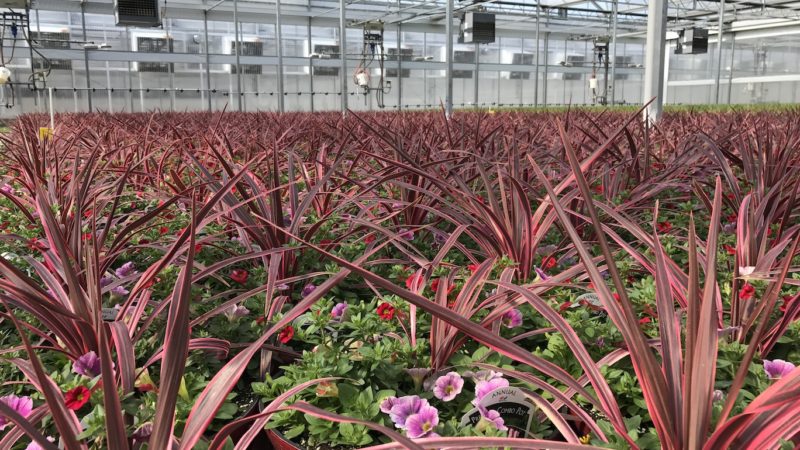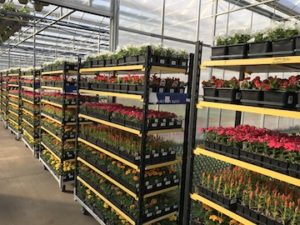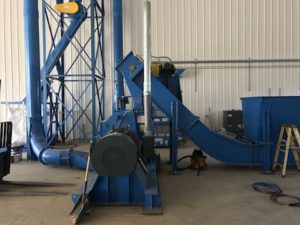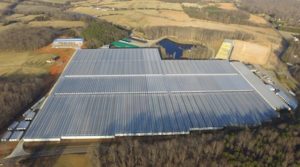
Cover Story — Improving Tomorrow from the Ground Up
American Color is a relatively young company but with amazingly deep family roots in the greenhouse business. Owner Ed Van Hoven built his first greenhouse growing transplants for vegetable starts just 20 years ago in 1998, but his operation has quickly expanded to one of the largest flower growers in the country.
Today the company has 30 acres of greenhouse space and 10 acres of outdoor production. They have managed to carve out a niche in the market and within their region that has given them a successful partnership with retailers like Costco and the new Lidl. Pair that with their contract business, and American Color is supplying a good portion of a 900-mile radius.
A SIMPLE, YET DIVERSE, BUSINESS PLAN
American Color has a fairly unique customer base, which has provided the opportunity to remain narrow and deep in their product line. From big box retailer Costco to up-and-coming grocery chain Lidl to contract growing for customers like Metrolina Greenhouses, the 30-acre greenhouse is busy year-round with a full range of product from bedding plant packs to combination baskets to mums and poinsettias.
According to Tom Costamagna, director of growing at American Color, being located in north central Virginia has been very beneficial not only from a climate standpoint but also geographically when it comes time to ship to various customers.

With Costco being the company’s largest customer, there is a lot of trucking involved.
“We service well over 100 Costcos,” says Costamagna. “We’re traveling as far south to Tallahassee. We go all the way back into Austin, Texas, and we go up to Illinois and back across to New York. It’s a pretty large region that we serve, but where we’re located, we’re kind of in the epicenter.”
Other customers include Lidl, a German-owned grocery chain that has emerged over the past couple of years but continues to expand, and Food City, a regional grocery chain.
Lidl is American Color’s newest customer, having come on just two years ago. “In Germany, Lidl is one of the largest grocery store chains,” shares Costamagna. “They recently (in the last two years) made northern Virginia their North American headquarters.”

For American Color, it’s been a valuable addition for multiple reasons. At a shipping level, they can ship directly to Lidl’s distribution centers located right in Virginia. At a production level, they offer a different product than other customers. “Their product line is narrow and deep but also high end at a very competitive retail price point,” says Costamagna. “When you look at their beer and wine selection, it’s very similar to a retailer like Trader Joe’s. With that, they have bouquets and pot plants and seasonal crops.”
And they are on an impressively fast growth pattern, with about 65 stores in the region currently and nearly a dozen coming on board in the coming months.
The company also does a fair amount of contract growing for Metrolina in North Carolina, Battlefield Farms in Virginia, Bell Nursery in Maryland, and Fernlea Flowers in Ontario, Canada. With those big names servicing customers like Lowe’s, Walmart and Home Depot, American Color must keep competition in mind and crossover in SKUs must be avoided.
“At the end of the day, we just have to break down the individual customers, whether they are American Color or contract,” says Costamagna. “Next thing you know, we really have 12 to 15 customers when you look at the SKU level. We try to keep the product categories separate.”
DEDICATED TO PRODUCT QUALITY
From the grandiose impulse planters at Costco to the 4-inch kalanchoe pots at the grocery chain to the packs and quarts at the contract level, American Color is growing it all. No retailer is the same, but they all want the same thing: high quality.
At American Color, plant quality comes in multiple levels — from the structure itself to the equipment used to the water and media used in each crop.
The way the greenhouses are set up, they are built on a 45-degree angle and can be run from truss to truss, rather than gutter to gutter, with shadows moving throughout the day. And all 30 acres of the greenhouse uses black cloth and boom lighting. This has allowed them to manipulate light, which has given them an edge in both spring and mum season.
“With our model, we like to be the first to the marketplace, not the last,” says Costamagna. “From a structural standpoint, the company has only been around 20 years, but if you walked into this facility, you cannot tell a different between the greenhouses that were built three years ago versus the greenhouses built in 1998.”
Likewise, when it comes to transplanting, Costamagna says, “There’s no question that technology is the future.”
That being said, the company has partnered with Ball Horticultural Co. and has implemented its AutoStix machine. “We can turn 10,000 cuttings an hour, and with our model being narrow and deep it works well,” shares Costamagna. “When we’re sticking geraniums or Sunpatiens, they are in large volumes and so we’re not really changing the machine.”
To give an example, Costamagna says a single hand stick line is usually composed of 16 people. With AutoStix, American Color has reduced that number to four.
While the labor savings have been huge, Costamagna sees the real benefit in the product quality. “When you see these trays in the greenhouse, every cutting has been stuck exactly the same. From a growing standpoint, this allows light, temperature and moisture to be very even across the trays.
“As you increase your uniformity, you decrease your shrink,” he affirms. “And you’re hitting or exceeding your targets.”
INNOVATIONS IN MEDIA
With plant quality being top of mind at American Color, the grower recently decided to make a huge leap in its media program.
“We went down the major change in eliminating perlite from our media,” says

Costamagna. “And we followed suit with what Young’s Plant Farm [in Alabama] has done and put a new twist on it. We invested in a mill, which is modeled after what Young’s has done more than a decade ago with trees.”
Unlike Young’s model, American Color does not own land and harvest its own trees.
“Here in Virginia, we’re covered in loblolly pine,” says Costamagna. “We can get wood chips on a regular basis and they are fairly inexpensive. The trees have been debarked prior to being chipped.”
What American Color has done with its mill, though, is they are pulverizing the wood chips first before running them through the hammer mill. What this does is, instead of having a micro wood chip, pulverizing creates long fibers 10 to 20 mm in length, that are very similar to coconut coir or long fiber peat. Their pine tree substrate is then combined with peat.
According to Costamagna, this provides increased water-holding capacity not only at the grower level but all the way to the consumer. The company has seen a decrease in water needs, as well as fertilization requirements. And for consumers, they don’t have to water their plants every day or twice a day in the summertime.
ADVANCEMENTS IN INTEGRATED PEST MANAGEMENT
Before joining American Color, Costamagna spent a decade in the University of California-Davis research program studying pest management systems around the world. “We had projects in Spain and Morocco, and so I was exposed to a lot of different growing systems,” he shares. “And over the course of time, traveling through South America, there was a huge movement now dating back 20 years where we worked with finding alternative means for disease and pest control.”
During this time, Costamagna witnessed growers fermenting their own technologies. Toward the later part of his visits, he discovered they were using a material called EM or effective microorganisms, which he was looking into then and learning how it could be used and manipulated in the U.S.
He has since taken this knowledge and implemented a similar program at American Color where they are developing AEM or activated effective microorganisms. “It is
our first line of defense in the greenhouse, which we inject into our irrigation water,” he says.
AEM is not a pesticide and therefore does not contain chemicals. Rather it is a microbial inoculant that functions as a biological control measure through the introduction of beneficial microorganisms to the plant environment.
What this new process has done for American Color is instead of being reactionary, they are now innovative in their pest and disease control. The company still uses synthetic products, paired with other biopesticides, but it is truly an integrated approach.
“We have multiple layers verifying problems and dealing with them,” says Costamagna. “But the last thing you want to do is be reactionary and spray all 30 acres when you have one problem in three posts.”
AMERICAN COLOR AT A GLANCE
Year Founded: 1998
 Location: Orange, Virginia
Location: Orange, Virginia
Production size: 30 acres indoors, 10 acres outdoors
Key Management: Ed Van Hoven, owner/president; Brandon Van Hoven, vice president; Tom Costamagna, director of growing; Reese Boyd, director of sales
Number of Employees: 100 full time, between 200 and 250 during peak season
Customer Base: Costco, grocery chains, contract growing for other large growers
SIDEBAR
INSPIRING FUTURE HORTICULTURISTS
American Color has deep roots in its Christian faith, and thus, being fair, being environmentally aware and applying good business practices are part of the company’s mission. From Ed Van Hoven’s foundation Bountiful Plant Ministries to partnering with MPS to implement sustainable plant production, the company aims to be socially responsible.
“At the end of the day, the family is all people of faith,” says Tom Costamagna. “They feel being blessed to be able to produce plants that produce profit, using sustainability allows them to participate and be involved in ministry.”
In addition, the company has partnered with Ohio State University to host eight international interns, which have become a base layer of the growing staff. The students come from other countries, like China, the Philippines, Peru and Guatemala.
“It’s amazing as we go through the process,” says Costamagna. “They may not be making a whole lot of money in American dollars, but $10 here is like $50 an hour for them.”
It has been gratifying for Costamagna and the management staff at American Color to witness the interns’ experience, growth and future employment.
“I’ve only been here two and a half years, and I’ve had interns that worked here in our 30-acre facility and now run an 80-hectar tomato facility in South Africa. It is about the individual and their aspirations. You feel a part of their success by what they learn and what we’re able to teach them in their short time here at American Color.”









 Video Library
Video Library 


















